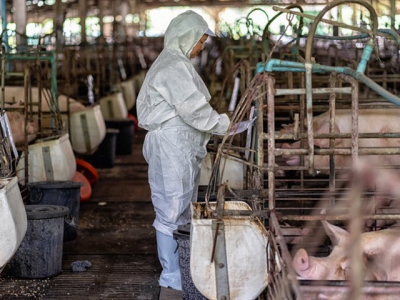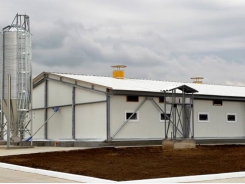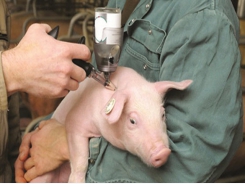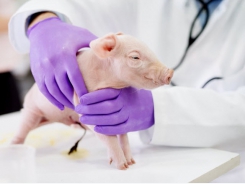Tracking ASF survival in feed could help with mitigation efforts

Expanding the understanding of how long African Swine Fever survives in complete feed and feed ingredients and tracking the virus’ half-life may improve mitigation strategies, says KSU researcher.
There has been an understanding that the African Swine Fever virus (ASFv) can be present in contaminated pork products and blood for some time, said researchers in a study published in Emerging Infectious Diseases. However, less is known about the disease’s ability to survive in complete feed and feed ingredients.
Information generated in an initial study had limited data, but enough to generate an understanding of the virus’ half-life, they said.
In an effort to build on those initial insights, a new study tracking the stability and survival of ASF in multiple feed ingredients and complete feed has been completed, said Megan Niederwerder, corresponding author and assistant professor at Kansas State University (KSU).
The latest research provides quantitative data on the half-life of ASFv Georgia 2007 in animal feed ingredients exposed to moderate temperature and humidity conditions simulating transoceanic shipment. The team involved concluded that the feed matrix provides an environment that increases ASFV stability. They said these data provide additional evidence supporting the ability of plant-based feed ingredients to promote survival of ASFV should these products become contaminated.
“The research on viruses in feed is really in its infancy, and we’re really learning a lot about the stability of the virus in feed, the half-life of the virus in feed, what feed ingredients promote survival [and] transmission through feed,” Niederwerder told FeedNavigator. “As we gain more information, it’s exciting, as we’re able to provide this novel, quantitative data that can assist with implementing risk mitigation strategies.”
The new study builds off of previous work exploring the survival of the Porcine Epidemic Diarrhea (PED) virus and other diseases in feed, she said. “The objective of the new study was to confirm the initial results that ASF could survive in feed ingredients, and to increase the number of titers available to us in order to understand how the virus decayed over time,” she added.
“We measured the quantity of virus and increased the amount of information by eight-fold from the initial study,” she said. “Using that information, we were able to calculate more robust half-life estimates.”
Understanding virus half-life
The half-life data can be used to provide a timeline to help assess mitigation strategies used on feed or ingredients contaminated with the virus and to develop potential mitigation protocols, she said.
“Based on the half-life, you can take that information and between 5 to 7 half-lives you can reduce the quantity of virus by 97% to 99% – so it gives us a time period in relation to the quantity of actual virus.”
“If you investigate viral or bacterial load, the half-life over time is somewhat of a standard in regard to thinking about inactivation … now [that we] know the half-life in these transoceanic conditions so what happens if we use an antiviral chemical mitigant? Or we increase the temperature?” she said. “We can use that foundational knowledge to understand what these mitigation strategies do to the half-life and again it’s a way to quantify the efficacy of some of these mitigation strategies.”
The study results showed that the half-life of the virus ranged from 9.6 to 14.2 days in all the feed ingredients tested, she said.
Tracking ASF in feed, feed ingredients
In the trial, nine feeds and feed ingredients were inoculated with the ASFV Georgia 2007 strain of ASF and kept in an environmental chamber set with fluctuating environmental conditions, including humidity and temperature, intended to reflect a 30-day transatlantic shipment, the researchers said.
Negative controls – non-infected feed samples – and positive controls in the form of virus-containing media also were included in the trial.
Feed ingredients assessed in the trial included organic and conventional soybean meal, soy oil cake, choline, cat and dog foods and complete feeds.
Samples were checked for virus level on days 1, 8, 17 and 30, they said. The half-life of the virus in each feed or ingredient sample was calculated.
Implications
A future step will be to provide recommendations for feed or ingredient storage based on storage conditions and virus degradation, said Niederwerder.
“We’re doing a lot of research on the mitigation strategies,” she said. “One of the mitigation strategies is storage time, so as we think about half-life validation or coming up with a recommendation with regard to the length of the storage time necessary to reduce the viral load by 99% we can use that half-life to estimate storage recommendations.”
The study also found that the virus was more stable in feed or feed ingredients than it was in the media used as a host in laboratory conditions, she said. “The half-life of the virus in media was shorter than all of the half-lives of the virus in feed matrices,” she added.
There also was a variation between the stability of the virus in different ingredients, Niederwerder said. ASF survived the longest – about 14.2 days – in the complete feed.
“That’s interesting because complete feed is likely less of an importation risk, some of the ingredients are more of an import risk from countries like China,” she said. The difference in virus stability is thought to relate to variability in elements like fat, moisture or protein in the feed ingredients, but the exact cause has yet to be determined, she added.
Additionally, the half-life of the virus was three days longer for organic soybean meal than conventional soybean meal, she said.
“This goes back to looking at, thinking about feed biosecurity, thinking about where your feed ingredients are imported from, [and] knowing how many of your ingredients or which ingredients are coming from countries that have a circulating foreign animal disease such as ASF,” said Niederwerder.
Source: Emerging Infectious Diseases
Authors: A. M. Stoian, J. Zimmerman, J. Ji, T. J. Hefley, S. Dee, D. G. Diel, R. R.R. Rowland, and M. C. Niederwerder
Related news
Tools

Phối trộn thức ăn chăn nuôi

Pha dung dịch thủy canh

Định mức cho tôm ăn

Phối trộn phân bón NPK

Xác định tỷ lệ tôm sống

Chuyển đổi đơn vị phân bón

Xác định công suất sục khí

Chuyển đổi đơn vị tôm

Tính diện tích nhà kính

Tính thể tích ao




 Longitudinal investigation of swine gut microbiome published
Longitudinal investigation of swine gut microbiome published  Changing piglet feeding schemes and management approach is…
Changing piglet feeding schemes and management approach is…